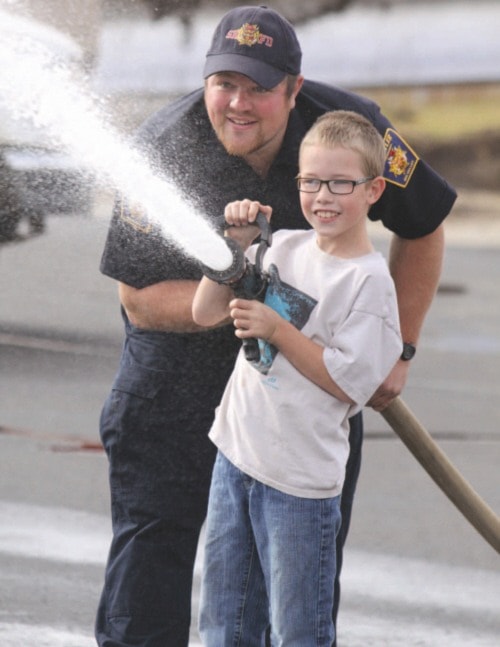As the Stettler Fire Department partnered with ATCO Electric on Monday night for the annual community food drive, firefighters advised homeowners to check batteries in their smoke detectors.
“This is an event we do every year,” said Mark Dennis, the Stettler Regional Fire Chief.
“We also asked whether people have two escape routes planned for their homes and at work, and knowing what the family needs to do in the event of a fire.”
The regional fire organization also hosted an open house last Saturday at the Stettler fire hall, which features a new paved parking lot.
Along with lunch, visitors were treated to a demo with fake smoke, using a thermal imaging camera, and interaction with the local firefighters.
National Fire Prevention Week runs from Oct. 6 to 12. This year’s theme for fire prevention week is home-cooking fires, the No. 1 cause of household fires.
“Panic is one of the biggest problems with home-cooking fires,” Dennis said.
“Fires over the past 20 years are trending down, but the seriousness of fires is not, because of all the new construction methods and different materials from years prior.
“Fires are burning much more rapidly. The time window from when smoke detectors go off until the time to evacuate the house is decreased immensely. It has gone from 20 minutes to less than two, till the room is fully engulfed. Until you see it with your own eyes, it’s very hard to believe.”
The measurement of just how ferocious fires burn is measured by a specific calculation by the amount of fuel load present.
“It’s astonishing the amount of fuel load that is in our homes today,” Dennis said. “Everything in our homes is made of hydrocarbons, which involve plastics and manufactured woods (made from glues and other added residents).
“The type of smoke that comes off the fuel load is very toxic. You don’t want to be breathing it in for a very long time. The furniture we have today is highly flammable. People have to be aware and cautious to prevent fires.”
Stettler regional firefighters have attended the educational fire departments’ instructors conference in Indianapolis, bringing back new training information on techniques to teach firefighters how to be safe not only for themselves, but for fire-prevention activities.”
“The techniques we use today have changed completely from years past,” Dennis said. “The reason being, because of the speed in which a fire is burning, it has caused the time to look for victims in a burning building to be significantly reduced, from the time we get the call to the time we get on scene. Because of the time decrease, we are not able to take in hand lines (waterlines). We also don’t have time to ventilate with high-pressure fans before we search for victims.
“Scientific (fire) information has brought forward better ways to inform us as firefighters and as leaders to effectively fight the fires and promptly prevent the fires from happening.”
Construction methods and the close proximity of homes in busy centres have contributed to high-intensity residential fires, the Stettler chief said. “Fires are now able to spread from one house to three,” Dennis said.
Fire prevention activities help educate people and let them know that they can take action to prevent fires from happening and spreading to their neighbour’s houses, or vice-versa.
“By limiting the amount of vegetation beside and around your house, and not storing firewood directly against your house and using asphalt shingles opposed to cedar shakes, all can impact the chance of a greater fire at your house and your neighbor’s,” Dennis said.
“This year, we started a fire smart in your community, a program that’s designed for the wildland interface (such rural-type areas). Rochon Sands was chosen because of its geographical location. The houses are very close together, quite a distance from the fire department, a large grouping of trees and built in the side-hill lake situation.
“We are hoping to spread to other communities around the lake area, and eventually that will move into the larger communities.”
The Stettler region has been exemplary in its fire-prevention efforts, the chief said.
“I’m pretty proud that we are one of the communities that have started doing this outside of the forest-protection area,” Dennis said.
“We have to take it upon our shoulders and carry the cost of the fire prevention activities within our own budget. However, we think it’s important that we are doing these types of activities within the communities.”
It’s been categorized as a moderate year for fighting in the Stettler region.
“This year I wouldn’t say we had a lot of fires, meaning an average year,” Dennis said. “A fairly busy spring, typical fall, as far as wildland fires. Structure fires, pretty much the status quo.
“We have been busy training our personnel. Across the province, the most important activity that we had next to fire prevention is recruitment. Trying to find and maintain trained the volunteer firefighters at all four stations, including Stettler, Donalda, Big Valley and Byemoor, is our No. 1 focus this year.
“We have a well-trained force. Within the paid part-time atmosphere, we don’t know who will be able to come to every call. Our members are very well-trained for all types of situations that can occur. You never know what is going to happen — that is what makes it exciting and challenging. My job is to keep all our members trained and up to speed with all the new techniques (and) tools, and keep them outfitted so we can provide the best service we can to the community. It’s pretty rewarding and exciting.”
